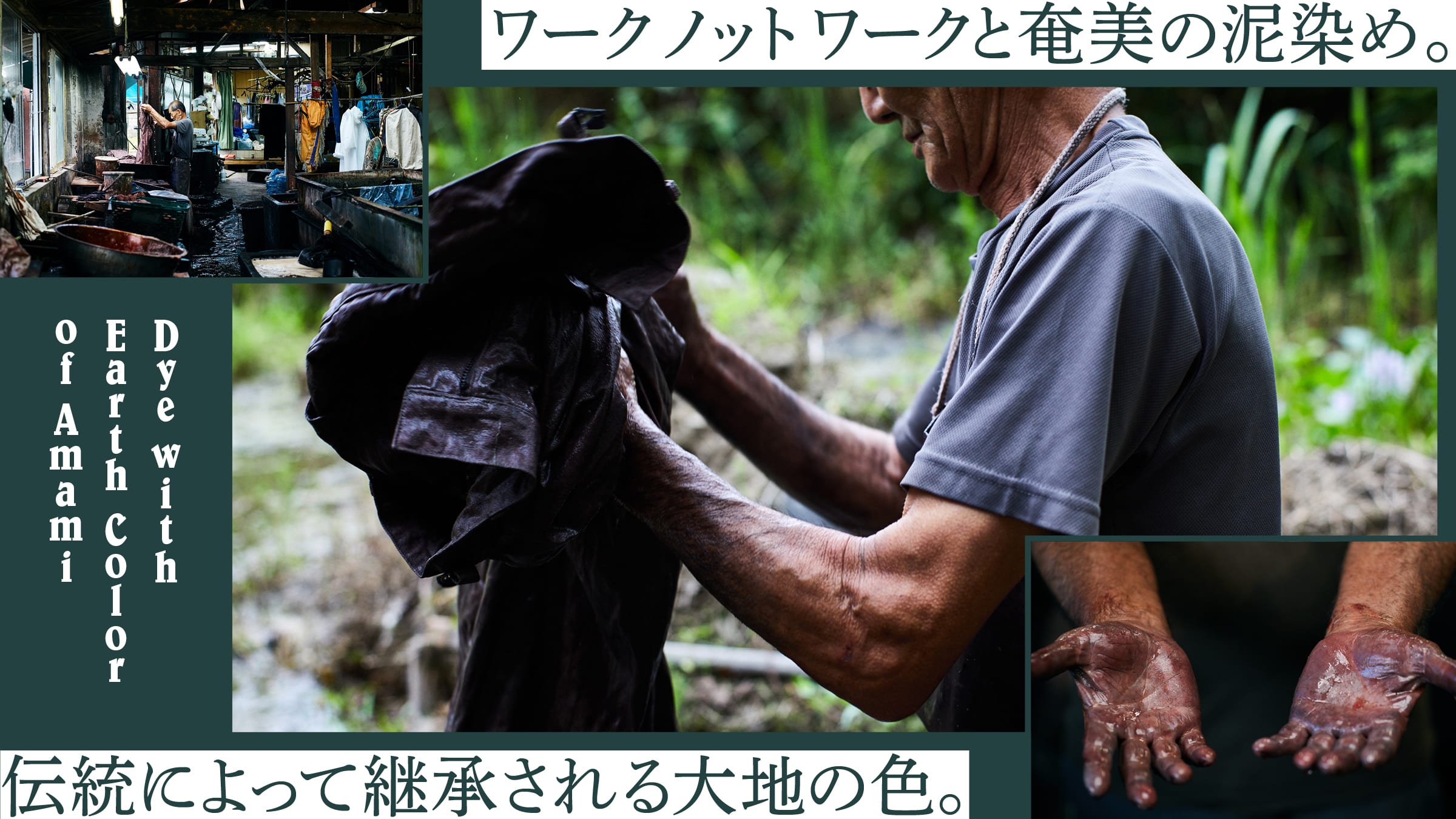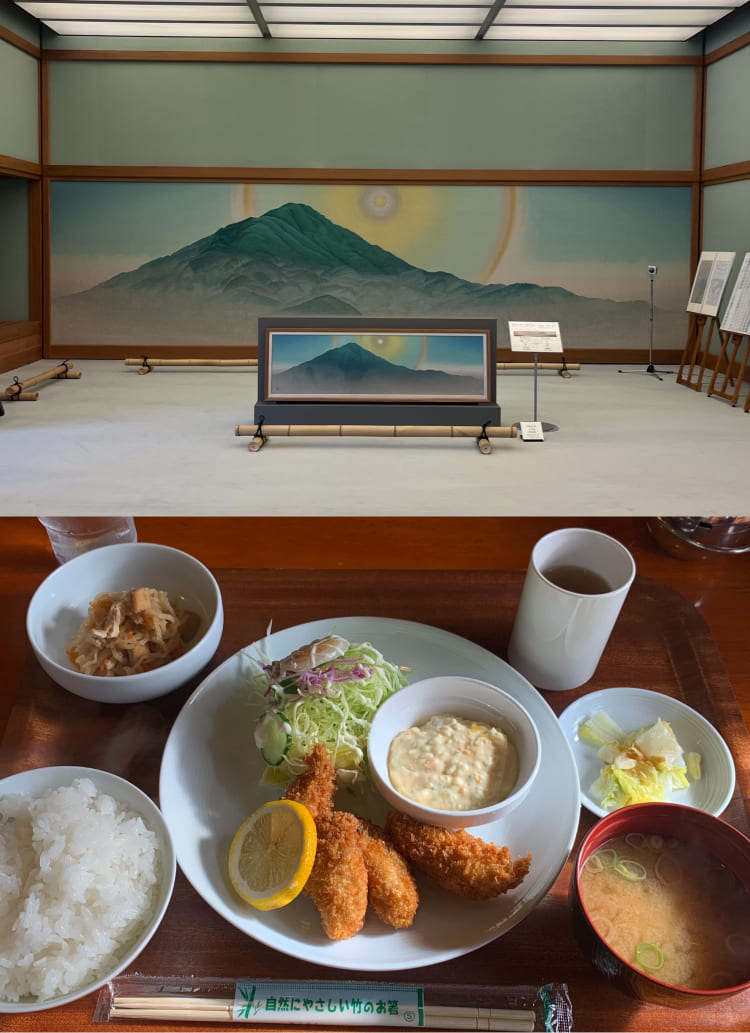The tannins of the teechee wood and the iron content of the mud. The chemical reaction of nature's
Interestingness.

The fabric is pure white before dyeing. The printed pattern was sampled from a manhole cover.
This season, we are reflecting motifs related to "the road" in our creations," says Yoshida.
This time, "Work Not Work" has produced a set-up for men and women. The fabric is a thick cotton twill. It is characterized by its moderate tension and firmness.

The teich tree is also known as the wheeled plum tree (sharin-bai). It was growing in the workshop and had fruits the size of a pachinko ball.
. when I was little," the master said with a laugh, "I used to eat it all the time.
In order to do mud dyeing, it must first be prepped with a dyeing method called tecchi-wood dyeing.
Tatechi wood contains tannin, an acidic component, which reacts with the iron in the mud to produce mud-dyeing. Therefore, even if you dye with mud, you will not get the same color as Oshima tsumugi.
Before starting the dyeing process, the master explained so to me. Teach tree is an evergreen tree that grows abundantly on the island . After the tree is purchased from a vendor and turned into chips in the workshop, it is boiled down in a large pot to extract the extract that will become the dye.

. outside the workshop was a pile of teche wood. From here, the wood is chipped as needed.

The reddish center of the trunk means that it contains more tannin . About 600 kg of chips are boiled in a large kettle at a time.

The freshly extracted extract is reddish-brown and coffee-like in color, but from this state, it is allowed to sit for about a week to oxidize.

When oxidized, it turns a brick color as shown in the photo. It has a unique aroma, and the workshop was filled with a twangy smell.
Since the amount of tannin contained in teche wood changes depending on the time of year, it is the craftsman's job to dilute the tannin with water to achieve the proper quality. This is then used to dye the items.



Junichi dyes items vigorously, using his entire body. He says that his fingernails are always in a deep nail state because they come in contact with the vessel during rubbing.
The dye must be allowed to penetrate thoroughly in order to be dyed beautifully, and it is necessary to rub and press the dye many times.
It's our job to make sure it's as clean as possible."
The master says so with a powerful gaze. On the other hand, "Work Not Work" ordered a thinner dyed finish this time. Compared to Oshima silk, which is usually dyed jet black, it is particularly difficult to achieve a thin finish.
The lighter the color is, the more difficult it is to keep it from becoming uneven. Moreover, it is impossible to achieve the desired color without experience. Because we are working with nature, we can't just calculate colors like we can with chemical dyes.
There was a lot of back and forth between "Work Knot Work" and "Higo Dyeing" in the making of this item. The masters had doubts about the thin finish, while "Work Knot Work" thought that a thin finish would be better. Mr. Yoshida talks about this.
Higo Dyeing said they did not want to do this unless they were satisfied with the even finish, but when we saw a sample of this thin finish, we thought, "This is what we want. We saw a sample of this thin finish and thought, 'This is what we want.' We fell in love with the soft look, including the unevenness, and felt the taste of being dyed by human hands. So, we decided to have it done somehow with this thin finish.

If the dye is not rubbed in with air, it will not react with the mud later. The presence of bubbles is evidence of the presence of air.
Oshima silk, which is usually dyed, is silk yarn. Compared to that, the fabric used for this project is harder and stiffer, so it is quite hard work. Mr. Yoshida, the MD who was experiencing the mud dyeing, said, "I have dyed T-shirts, but it was hard work because you have to put strength in your waist and grip. So dyeing a fabric of that thickness is harder work than it looks. Despite this, the master and Junichi continued to work silently, and I felt as if I had seen the pride of a craftsman in their work.

Lime is used as a building material and in agriculture. That it is also used for dyeing is new to me .

This time, the teech wood dyeing and the lime water are repeated back and forth three times.
The process takes about 30 minutes, but it is quite hard work as only a limited number of pieces can be dyed at a time.
Once the extract of the teh-chi wood has been absorbed, the items are dehydrated and now soaked in lime water. Once the fabric has been dyed with teh-chi wood, the oxidized tannin will cause it to become acidic, and the alkalinity of the lime will neutralize the acidity. This accelerates the oxidation process when the fabric is dyed again with tahiti wood, resulting in a darker color. The process of dyeing is repeated back and forth between the teche and lime water until the desired color is achieved, and then the next step is the mud dyeing process.

Lime is used as a building material and in agriculture. That it is also used for dyeing is new to me .

The mud fields are located about a five-minute walk from the workshop. . Many of the mud fields have now been reclaimed into sugarcane fields.

Mud dug up from the deep layers of the mud field. Because of its fine and rounded particles, it can be used to dye Oshima silk without damaging the silk threads.
Mud dyeing is done in the mud fields near the studio. According to the master, Amami has an abundance of mud containing a lot of iron.
After rice is grown and harvested in the rice paddies, fertilizer is added to the soil to make the rice grow again. In the old days, plants and trees growing in the area were used as compost to nourish the rice paddies. Over time, this turned into mud that contained iron. That's why newly created rice paddies have less iron in them, so the rice is not dyed as well as it should be.


The items are wriggled deep into the muddy field and dyed while the mud is rubbed in here as well.
. Because of the waist-deep mud paddies and the unstable footholds, this is also quite hard work.
The mud fields usually used for mud dyeing are enclosed inside. By doing so, the concentration of iron is stabilized. In the actual process, the items are dipped into the mud field and rubbed in the same way as when they were dyed with tecchi-wood. This causes a reaction between the tannin in the teetchwood and the iron in the mud, which dyes the fabric black. The items are carefully dyed one by one to ensure that the color is even.

. The river along the mountain was flowing somewhat swiftly because of the rain that had fallen the day before. When it gets dark, fireflies can be seen near here.
Next, we go to the river to remove excess mud. Here, too, the items are washed one by one. During the warm summer season, the work here is said to heal the body. Junichi says, "Mud dyeing is all natural, so washing here does not pollute the river. Indeed, the only materials used for dyeing are teche wood, lime, and mud. As if to prove the river's limpidness, many nocturnal shrimps swim in the river at night.

The color you see is the result of the tannins in the teich wood reacting with the iron in the mud.
. The interesting chemical reactions that nature causes are evident here.
So, the dyeing process is now complete. All that remains is to hang the item and wait for it to dry.









